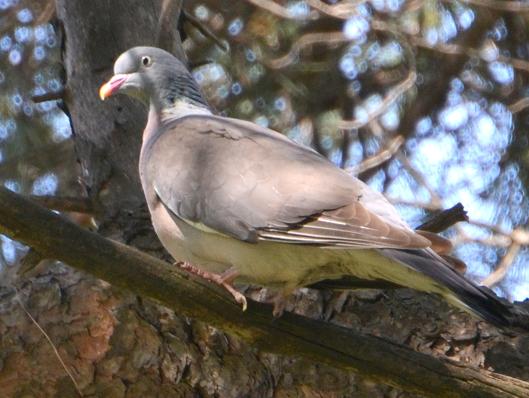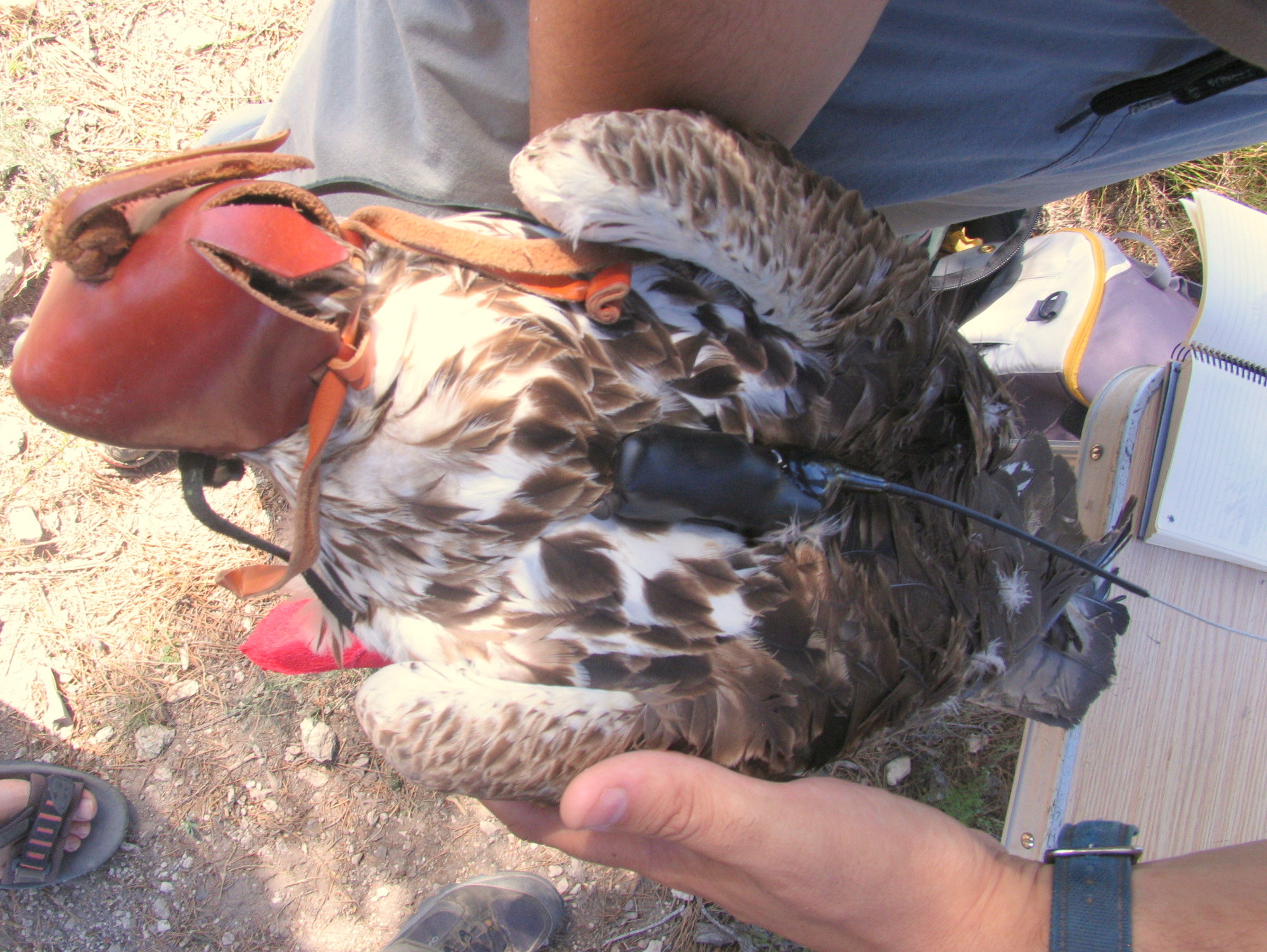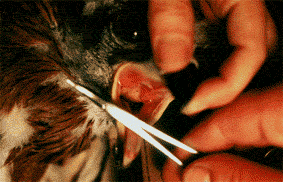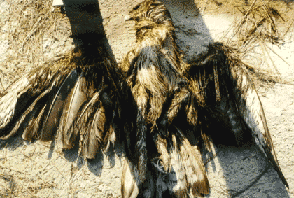Annual monitoring of the Catalan population
At
the beginning of the 80s we started to do an annual monitoring of the
population of Bonelli´s Eagle in Catalonia, together with other
naturalists and administrations. Since 1991 the demographic parameters
of a sample of 40-60 territories of eagles are followed annually.
The information gathered in the field is: the occupation of the
territories, the valuations of reproduction and of adult mortality.
From the obtained information it is elaborated a demographic data base
of the Catalan population of Bonelli´s Eagle.
Go to "Research"
|
 |
Demography of the species
|

|
Task:
Making of mathematical models to see the principal parameters involved
in the demographic maintenance and conservation of diverse Iberian and
French populations.
Principal results:
The model allows to foresee how a population will evolve considering
the principal demographic parameters: adult mortality, pre-adult
mortality and productivity. The adult mortality has an effect 4 times
higher than the pre-adult mortality and 10 times higher than
productivity.
Bibliographical references: A3, A11, A12, A29, A30, B9, C10, C13, C14, C15, D1, D2, E3, E5 i E10.
Go to "Research"
|
Diet and prey selection
Task:
Description of the diet from collection of pellets, prey remains and
fieldworks observations. Study of the selection of prey and of the
plenty of nourishing resources in different geographical areas of the
Catalan population.
Principal results:
The rabbit seems to be the ideal prey of the eagles. When this one is
scarce, the eagles have to extend his range of preys, which normally
consists of species more difficult to capture and of minor weight and
energetic value. In the last decades there has been detected a decrease
of the presence of the rabbit in the diet of the eagles related to a
decrease of this prey in the environment, because of changes of
habitat, hunting pressure and diseases.
Bibliographical references: A10, A23, A31, B3, B6, B7 i E7.
Go to "Research"
|

|
Use of the territory and habitat selection
|

| Task:
Marking and radio tracking of adult individuals of different pairs of
the regions of Barcelona, with the target to know the extension of
their territories, the habitats that they select and the interaction
with the human activities.
Principal results:
The preliminary information indicates that the eagles concentrate their
activity on areas near to the nest, provided that in these areas they
realize the reproduction, though they also exploit areas quite far from
the nests, in search of their ideal preys. Differences between the
pairs exist with regard to the entire exploited area and the areas most
used in the territory. The eagles select to hunt Mediterranean open
habitats (garrigues and small crop areas of dry land with a human
traditional activity), where they find a greater quantity and variety
of preys.
Bibliographical references: A25, E11, E16 i E18.
Go to "Research"
|
Breeding areas
Task:
characterization of the breeding areas of the eagles according to
demographic, climatologic, topographical, habitat and human activities
parameters. Analysis of all these variables to determine the state of
conservation of the breeding areas of their territories. Implementation
of all this information in a Geographical Information System.
Principal results:
the breeding areas of the unoccupied territories are usually more
abrupt, they have a colder and humid climate, and the entropic
parameters have more influence in the productivity than in the
mortality. The entropic factors that affect the productivity more
negatively are those related to human activities afoot realized next to
the nest, and also the presence and proximity of roads and tracks.
Bibliographical references: D1 i D2.
Go to "Research"
|

|
Biology of the reproduction and behaviour
|

| Task:
Studies on the phenology and the factors that influence the
reproductive success. Study of the behaviour of the adults during the
reproductive period. Development of the methodology to determine the
sex and the age of the chicks.
Principal results:
The phenology of putting and the reproductive success of the eagles
changes with the climatology, the diet quality and the age of the
parents. The eagles that eat more rabbit and have more food lay the
eggs earlier and produce more chicks. Non-adult eagles produce fewer
chicks than adults. There exists a division of the adult tasks during
the reproduction according to the sex. The females incubate and care
for the chicks, and the males hunt, take food to the nest and defend
the territory. From a young age, the female chicks are bigger than the
males. The age of the chicks in the nest can be determined according to
the length of the flight feathers.
Bibliographical references: A2, A6, A8, A9, D1 i D2.
Go to "Research"
|
Emancipation, juvenile dispersal and recruiting
Juvenile emancipation
Task:
Marking of 5 juveniles with transmitters. Monitoring of their
displacements during the 4 - 5 months following the abandonment of the
nest.
Principal results:
The juveniles leave the nest without being able neither to fly nor to
manage by themselves. During the first month they learn the different
types of flight, beginning with the simplest (flapping) up to the most
complex (soaring). Until the second month the adults continue feeding
the young eagles. From the third month it begins the independence
period and the young eagles leave the parents territory.
Bibliographical references: A12, C6, C11, E2 i E6.
|

|
Juvenile dispersal
Task:
Marking of 122 juvenile with rings and feather marks to locate the
dispersal areas and to know the selection of the type of habitat.
Principal results:
The dispersal areas where the juveniles concentrate have been located;
these are territories where there are no adults (with adult absence),
of soft relief and rich in preys. The young eagles that are born in
Catalonia can fulfil two types of displacement: of short distance,
principally in the areas of dry land of the central depression of
Lleida, and of long distance, in different points placed out of
Catalonia, such as the Sierra de Escalona (Alicante), Campos de Montiel
(Albacete), region of Jerez and Laguna de la Janda (Cadiz), Valle del
Tajo (Toledo) and other zones of the centre of the Iberian Peninsula
and Extremadura. The habitats selected by the juveniles are dry farming
areas that alternate with bushy areas that have a great plenty of
rabbit and partridge. During this period it has been detected a high
mortality caused by electrocution with electrical lines and direct
persecution (shooting).
Bibliographical references: A13, A18, C18 i E4.
| 
|
Recruitments
Task: Monitoring of the recruiting of the juveniles marked in the population of origin or in other areas.
Principal results:
Non-adult individuals visit nesting areas and replace the casualties of
adults in those territories with unpaired individuals. There is a
certain tendency to return to the natal territories. During the
dispersal period there is a high mortality, which bears a low valuation
of recruiting.
Bibliographical references: A24, D1 i D2.
Go to "Research"
| 
|
Mortality

| Principal results
Task: Study of the trichomoniasis in chicks of Bonelli's Eagle and of the ecological factors involved in its spread.
Principal results: Trichomonas gallinae
is a protozoan of which several birds are carriers. Despite the high
occurrence of trichomonas in chicks of Bonelli´s Eagle, only a small
percentage develops the disease and consequently dies during the
nestling period. In the case of the eagles, the infection is mainly
caused by the ingestion of doves, which are increasingly present in the
diet of the eagles. This increase in the consumption of doves is
related to their availability in comparison with other wild prey
populations (decrease of the optimal preys) and to the incorporation of
young eagles (non-experienced parents) to the territories. The disease
seems to be more and more frequent in several populations of eagles
such as the French, the Portuguese and some in the Spanish state.
Bibliographical references: A15.
|

| Causes de mortalitat a l’estat espanyol
Task: Study of the causes of mortality throughout the decade of the 90s in the whole Spanish state.
Principal results:
The principal causes of adult and pre-adult mortality are the
electrocution in power lines and the direct persecution. The causes of
mortality change according to the regions, the nesting or dispersal
areas, and the age of the eagles. It stands out the high adult
mortality for electrocution in Catalonia, which is related to the
increase of dangerous power lines during the decade of the 90s and the
substitution of (safe) wood supports for very dangerous metal supports.
It is necessary to notice that in certain areas the persecution of the
eagles for hunting reasons still continues.
Bibliographical references: A17 i A26.
Go to "Research"
|
|

